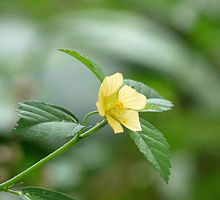Sida rhombifolia
| Sida rhombifolia | |
|---|---|
 |
|
| Scientific classification | |
| Kingdom: | Plantae |
| Clade: | Angiosperms |
| Clade: | Eudicots |
| Clade: | Rosids |
| Order: | Malvales |
| Family: | Malvaceae |
| Genus: | Sida |
| Species: | S. rhombifolia |
| Binomial name | |
|
Sida rhombifolia L. |
|
Sida rhombifolia (arrowleaf sida) ( Sanskrit : atibalā अतिबला ) is a perennial or sometimes annual plant in the Family Malvaceae, native to the New World tropics and subtropics. Other common names include rhombus-leaved sida, Paddy's lucerne, jelly leaf, and also somewhat confusingly as Cuban jute,Queensland-hemp, and Indian hemp (although S. rhombifolia is not related to either jute or hemp). Synonyms include Malva rhombifolia. It is used in Ayurvedic medicine, where it is known as kurumthotti. This is another species, native to India, Sida cordifolia (White Mallow)
The stems are erect to sprawling and branched, growing 50 to 120 centimeters in height, with the lower sections being woody. The dark green, diamond-shaped leaves are arranged alternately along the stem, 4 to 8 centimeters long, with petioles that are less than a third of the length of the leaves. They are paler below, with short, grayish hairs. The apical half of the leaves have toothed or serrated margins while the remainder of the leaves are entire (untoothed). The petioles have small spiny stipules at their bases.
The moderately delicate flowers occur singly on flower stalks that arise from the area between the stems and leaf petioles. They consist of five petals that are 4 to 8 millimeters long, creamy to orange-yellow in color, and may be somewhat reddish in the center. Each of the five overlapping petals is asymmetric, having a long lobe on one side. The stamens unite in a short column. The fruit is a ribbed capsule, which breaks up into 8 to 10 segments. The plant blooms throughout the year.
This species is usually confined to waste ground, such as roadsides and rocky areas, stock camps or rabbit warrens, but can be competitive in pasture, because of its unpalatability to livestock.
From The International Institute of Tropical Forestry, a division of the United States Department of Agriculture Forest Service:
...
Wikipedia
